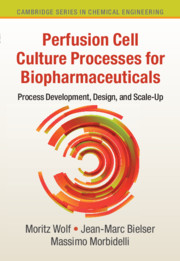62 results
5 - Clinical- and Commercial-Scale Reactors
-
- Book:
- Perfusion Cell Culture Processes for Biopharmaceuticals
- Published online:
- 17 July 2020
- Print publication:
- 06 August 2020, pp 100-137
-
- Chapter
- Export citation
Contents
-
- Book:
- Perfusion Cell Culture Processes for Biopharmaceuticals
- Published online:
- 17 July 2020
- Print publication:
- 06 August 2020, pp vii-viii
-
- Chapter
- Export citation
Frontmatter
-
- Book:
- Perfusion Cell Culture Processes for Biopharmaceuticals
- Published online:
- 17 July 2020
- Print publication:
- 06 August 2020, pp i-vi
-
- Chapter
- Export citation
List of Abbreviations
-
- Book:
- Perfusion Cell Culture Processes for Biopharmaceuticals
- Published online:
- 17 July 2020
- Print publication:
- 06 August 2020, pp ix-xi
-
- Chapter
- Export citation
1 - Perfusion Mammalian Cell Culture for Recombinant Protein Manufacturing
-
- Book:
- Perfusion Cell Culture Processes for Biopharmaceuticals
- Published online:
- 17 July 2020
- Print publication:
- 06 August 2020, pp 1-19
-
- Chapter
- Export citation
2 - Perfusion Bioreactors:The Set-Up and Process Characterisation
-
- Book:
- Perfusion Cell Culture Processes for Biopharmaceuticals
- Published online:
- 17 July 2020
- Print publication:
- 06 August 2020, pp 20-45
-
- Chapter
- Export citation
6 - Mechanistic and Statistical Modelling of Bioprocesses
-
- Book:
- Perfusion Cell Culture Processes for Biopharmaceuticals
- Published online:
- 17 July 2020
- Print publication:
- 06 August 2020, pp 138-173
-
- Chapter
- Export citation
Index
-
- Book:
- Perfusion Cell Culture Processes for Biopharmaceuticals
- Published online:
- 17 July 2020
- Print publication:
- 06 August 2020, pp 198-202
-
- Chapter
- Export citation
List of Symbols
-
- Book:
- Perfusion Cell Culture Processes for Biopharmaceuticals
- Published online:
- 17 July 2020
- Print publication:
- 06 August 2020, pp xii-xvi
-
- Chapter
- Export citation
3 - Scale-Down Models and Sensors for Process Development
-
- Book:
- Perfusion Cell Culture Processes for Biopharmaceuticals
- Published online:
- 17 July 2020
- Print publication:
- 06 August 2020, pp 46-66
-
- Chapter
- Export citation
References
-
- Book:
- Perfusion Cell Culture Processes for Biopharmaceuticals
- Published online:
- 17 July 2020
- Print publication:
- 06 August 2020, pp 174-197
-
- Chapter
- Export citation
4 - Design and Optimisation of Mammalian Cell Perfusion Cultures
-
- Book:
- Perfusion Cell Culture Processes for Biopharmaceuticals
- Published online:
- 17 July 2020
- Print publication:
- 06 August 2020, pp 67-99
-
- Chapter
- Export citation

Perfusion Cell Culture Processes for Biopharmaceuticals
- Process Development, Design, and Scale-up
-
- Published online:
- 17 July 2020
- Print publication:
- 06 August 2020
1 - Introduction to Biopharmaceutical Processes
-
- Book:
- Continuous Biopharmaceutical Processes
- Published online:
- 22 September 2018
- Print publication:
- 11 October 2018, pp 1-26
-
- Chapter
-
- You have access
- Export citation
Contents
-
- Book:
- Continuous Biopharmaceutical Processes
- Published online:
- 22 September 2018
- Print publication:
- 11 October 2018, pp v-viii
-
- Chapter
- Export citation
4 - Countercurrent Chromatography for the Capture Step
-
- Book:
- Continuous Biopharmaceutical Processes
- Published online:
- 22 September 2018
- Print publication:
- 11 October 2018, pp 110-152
-
- Chapter
- Export citation
frontmatter
-
- Book:
- Continuous Biopharmaceutical Processes
- Published online:
- 22 September 2018
- Print publication:
- 11 October 2018, pp i-iv
-
- Chapter
- Export citation
7 - Protein Aggregation in Biopharmaceutical Processes
-
- Book:
- Continuous Biopharmaceutical Processes
- Published online:
- 22 September 2018
- Print publication:
- 11 October 2018, pp 247-298
-
- Chapter
- Export citation
Notation
-
- Book:
- Continuous Biopharmaceutical Processes
- Published online:
- 22 September 2018
- Print publication:
- 11 October 2018, pp xi-xx
-
- Chapter
- Export citation
2 - Fundamentals of Protein Chromatography
-
- Book:
- Continuous Biopharmaceutical Processes
- Published online:
- 22 September 2018
- Print publication:
- 11 October 2018, pp 27-83
-
- Chapter
- Export citation



